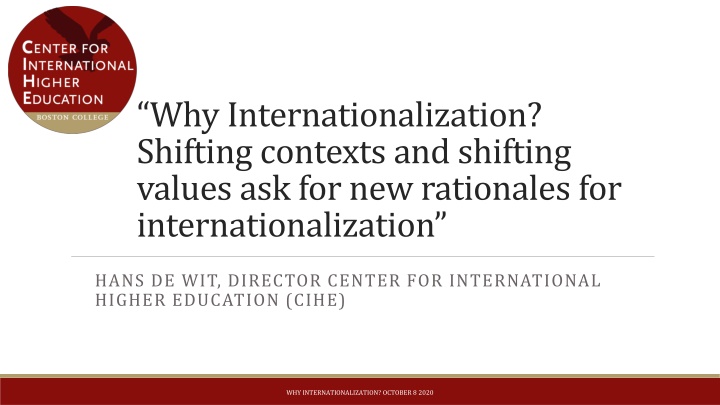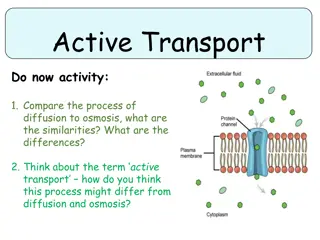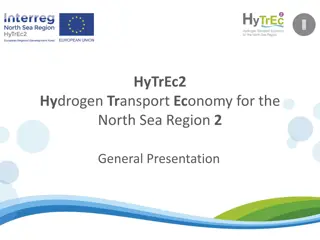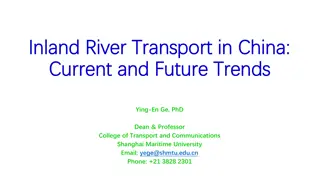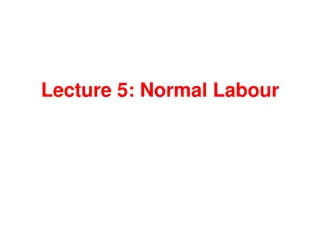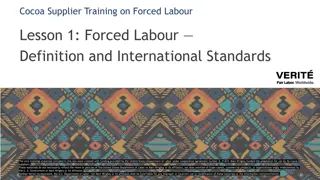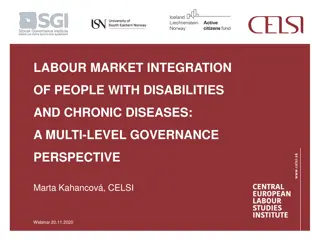Trends and Challenges in EU Transport Labour Market
This presentation highlights key trends, challenges, and opportunities in the EU transport labour market, focusing on workforce development, working conditions, skills needs, and policy goals. It also discusses the impact of digitalization, automation, and decarbonization on the transport sector, along with good practice measures and policy recommendations to address these challenges. Explore the structure of the presentation, key trends in the transport labour market, and the main challenges faced by transport workers.
Download Presentation

Please find below an Image/Link to download the presentation.
The content on the website is provided AS IS for your information and personal use only. It may not be sold, licensed, or shared on other websites without obtaining consent from the author.If you encounter any issues during the download, it is possible that the publisher has removed the file from their server.
You are allowed to download the files provided on this website for personal or commercial use, subject to the condition that they are used lawfully. All files are the property of their respective owners.
The content on the website is provided AS IS for your information and personal use only. It may not be sold, licensed, or shared on other websites without obtaining consent from the author.
E N D
Presentation Transcript
Why Internationalization? Shifting contexts and shifting values ask for new rationales for internationalization HANS DE WIT, DIRECTOR CENTER FOR INTERNATIONAL HIGHER EDUCATION (CIHE) WHY INTERNATIONALIZATION? OCTOBER 8 2020
Misconception about Internationalization We consider internationalisation too much as a goal in itself instead of as a means to an end. Internationalisation is not more and less than a way to enhance the quality of education and research and their service to society. WHY INTERNATIONALIZATION? OCTOBER 8 2020
As a strategic concept a relatively young phenomenon Institutional, local, national and regional context are essential in defining the why, what, how and outcomes of internationalization Internationalization in Higher Education Internationalization is driven by a broad range of rationales (political, economic, social-cultural, and academic) and stakeholders Not one single model that fits all Contexts and Rationales change over time, so it is a process and requires intentional actions Internationalization can be fragmented, ad hoc, marginal or central and comprehensive. WHY INTERNATIONALIZATION? OCTOBER 8 2020
Key Global Trends in Internationalization Growing importance of internationalization at all levels Trend towards increased privatization Competitive pressures of globalization, global rankings Evident shift from (only) co-operation to (more) competition Numbers rising everywhere, with challenge of quantity versus quality Will the changing global climate impact those trends? WHY INTERNATIONALIZATION? OCTOBER 8 2020
Two components but one concept: Global Learning for All Internationalization Abroad Internationalization at Home Campus internationalization Student Degree Mobility Internationalization of the Curriculum Student Credit Mobility Teaching and Learning Student short term Mobility Joint Programs Staff Mobility Intercultural and international competences and learning outcomes Program mobility WHY INTERNATIONALIZATION? OCTOBER 8 2020
Internationalization policies and strategies require answers to four questions The Why, based on Internal and External Context analysis The What, program policies and strategies The How, organizational policies and strategies And the Outcomes/Impact WHY INTERNATIONALIZATION? OCTOBER 8 2020
Internationalization Circle 8. Reinforcement Develop incentives, recognition, and rewards for faculty, staff, and student participation 1. Analysis of context Analyze the external and internal context in policy documents and statements 2. Awareness Of need, purpose, and benefits of internationalization for students, staff, faculty, society 9. Integration effect Impact on teaching, research and service function 3. Commitment By senior administration, board of governors, faculty and staff, students 7. Review Assess and enhance quality and impact of initiatives and progress of strategy 5. Operationalize - Academic activities and services - Organizational factors - Use guiding principles WHY INTERNATIONALIZATION? OCTOBER 8 2020 6. Implementation Implementation of program and organization strategies 4. Planning Identify needs and resources, purpose and objectives, priorities, strategies
Defining Internationalizationof HigherEducation Reflects increased awareness that IoHE must become more inclusive and less elitist Mobility must become an integral part of the internationalized curriculum that ensures internationalisation for all Re-emphasises that Internationalization is not a goal in itself, but a means to enhance quality Should not focus solely on economic rationales WHY INTERNATIONALIZATION? OCTOBER 8 2020
The intentional process of integrating an international, intercultural or global dimension into the purpose, functions and delivery of post-secondary education, in order to enhance the quality of education and research for all students and staff and to make a meaningful contribution to society Updated definition (de Wit et al, 2015, European Parliament Study) WHY INTERNATIONALIZATION? OCTOBER 8 2020
Requirements for the next decade post Covid-19 A return to a more cooperative and less market oriented approach Taking advantage of lessons learned in the pandemic: Realizing global learning for all, making use of online expertise, not by replacing onsite by online learning Link internationalization to the third mission, service to society (SDGs) Make internationalization more carbon-neutral, mobility is in itself positive but not available for all and not sustainable WHY INTERNATIONALIZATION? OCTOBER 8 2020
These are the key questions for internationalization in higher education in these challenging times As we look backwards and forwards, it is thus important to ask one question. What are the core principles and values underpinning internationalization of higher education that 10 or 20 years from now will make us look back and be proud of the track record and contribution that international higher education has made to the more interdependent world we live in, the next generation of citizens, and the bottom billion people living in poverty on our planet? (Knight and de Wit, 2018) WHY INTERNATIONALIZATION? OCTOBER 8 2020
In other words (De Wit and Leask, 2019, p. 1) Aligning the practice of internationalization with human values and the common global good requires that we first challenge some of our long-held views about what it is to be international as a university, a teacher, a student, a human being. This requires pushing the boundaries of our own and others thinking, focusing on people and ensuring that they develop and demonstrate the institution s espoused human values. WHY INTERNATIONALIZATION? OCTOBER 8 2020
Thank you DEWITJ@BC.EDU WHY INTERNATIONALIZATION? OCTOBER 8 2020
